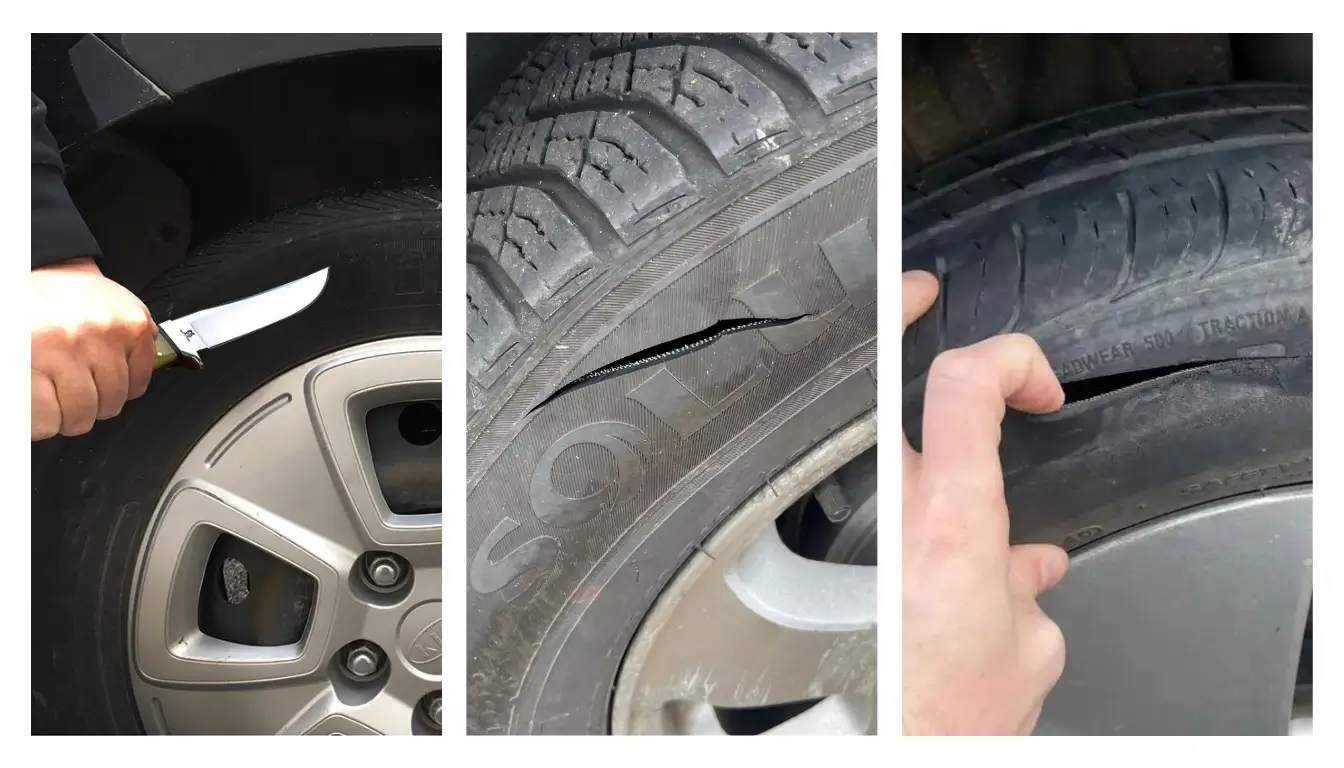Ever wondered, can you go to jail for slashing tires? The answer might surprise you. Learn the legal consequences and potential jail time before making a costly mistake.
Ever felt the urge to express your displeasure by, well, slashing someone’s tires? Hold that thought! Because while it might seem like a harmless prank, slashing tires is considered vandalism, and the consequences can be far from pleasant.
But wait, is slashing tires a felony? It depends. Depending on the location and the damage caused, it can be charged as either a misdemeanor or a felony. Confused? We’ll break it down for you.

Slashing tires is considered vandalism and can result in misdemeanor or felony charges, depending on the damage cost and state laws. Potential consequences include jail time, fines, restitution, and probation.
So, before you get carried away with your tire-slashing fantasies, stick around and learn about the consequences of slashing tires, including vandalism penalties and potential jail time in your state. We’ll also answer the burning question: can you go to jail for slashing tires in your state? Stay tuned!
Key Takeaways:
- Slashing someone’s tires is considered an act of vandalism and can lead to legal consequences.
- Tire slashing can be charged as a misdemeanor or felony, depending on the jurisdiction and the value of the damage.
- Punishments for slashing tires may include probation, fines, restitution, and imprisonment.
- Understanding the potential penalties can help make informed decisions and avoid serious legal consequences.
- Consulting with a legal professional is crucial to navigate the specific laws and regulations in your jurisdiction.
What is Considered Tire Slashing?
Tire slashing refers to intentionally damaging or puncturing the tires of a vehicle. It is a form of vandalism that involves using a sharp object, such as a knife or blade, to make cuts or gashes in the rubber. This act is illegal and can lead to serious consequences.
Tire slashing can occur on one or multiple tires of a vehicle, causing significant damage and inconvenience to the owner. It is a deliberate act of vandalism that aims to disrupt and destroy property. The image below illustrates the aftermath of tire slashing:

There are different types of tire vandalism, including:
- Deep Cuts: In this type of tire slashing, the perpetrator uses a sharp object to make deep, elongated cuts in the rubber. These cuts can severely weaken the tire and may lead to a blowout while driving.
- Surface Cuts: Surface cuts involve making shallow cuts on the surface of the tire. While they may not immediately cause tire failure, repeated surface cuts can accumulate and eventually compromise the tire’s integrity.
- Puncture Wounds: Puncture wounds involve piercing the tire with a sharp object, such as a nail or screw. These punctures can lead to slow leaks or rapid deflation of the tire.
- Slashing Multiple Tires: Some perpetrators target multiple tires on a vehicle, increasing the financial burden and inconvenience for the owner.
Tire slashing can have severe consequences, not only for the victim but also for the perpetrator. It is essential to recognize the gravity of this offense and discourage such destructive acts.
Legal Disclaimer: This article is intended for informational purposes only and should not be construed as legal advice. The laws and penalties surrounding vandalism, including tire slashing, vary significantly by jurisdiction. For specific legal questions and guidance, please consult with a qualified attorney in your area.
Potential Criminal Charges for Tire Slashing
Tire slashing, being a criminal act, can lead to various charges depending on the jurisdiction and specific circumstances surrounding the offense. It is important to be aware of the potential criminal charges associated with this offense, as they can have severe consequences for offenders.
So without further ado, let’s find out everything about the different types of charges that can be filed for tire slashing, including the distinction between misdemeanors and felonies, additional charges that may apply, and state-specific variations in charges and penalties.
Misdemeanor vs. Felony Charges: Understanding the Thresholds
Generally, tire slashing is considered a misdemeanor offense, which is a less serious criminal charge. However, there are certain thresholds that, when crossed, can elevate the offense to a felony charge. These thresholds typically involve the value of the damage caused or the presence of aggravating factors.
If the damage caused by tire slashing exceeds a certain monetary value, or if there are aggravating factors such as targeting specific individuals or causing harm to others, the offense can be charged as a felony, which carries more severe penalties.
Additional Charges That May Apply
In addition to the charge of tire slashing, there are other charges that may apply depending on the circumstances of the offense. Some common additional charges include criminal mischief, disorderly conduct, and vandalism.
These charges are filed based on the specific actions and intent of the offender, and they can further compound the legal consequences associated with tire slashing.
State-Specific Variations in Charges and Penalties
It’s important to note that charges and penalties for tire slashing can vary from state to state. Each state has its own set of laws and regulations regarding this offense, which can result in different classifications of charges and varying severity of penalties.
Therefore, it is crucial to familiarize yourself with the state-specific laws on tire slashing if you find yourself facing criminal charges related to this offense. Understanding the particularities of your state’s legal framework will help you navigate the situation effectively and seek appropriate legal counsel.
You might also like: Why Do You Only Slash 3 Tires Instead Of 4? The Surprising Truth
Can You Go to Jail for Slashing Tires? Here’s The Shocking Truth
Yes, it is possible to go to jail for slashing tires. While a first-time offense may result in probation, fines, or other penalties, repeat offenders or those who cause significant damage may face imprisonment. The length of the jail term will depend on the severity of the offense and the jurisdiction’s laws.
Slashing someone’s tires is considered an act of vandalism, which is typically classified as a misdemeanor. However, depending on the value of the damage and the jurisdiction, it can also be charged as a felony. The legal consequences for tire slashing can include probation, fines, restitution, and even imprisonment. It’s important to understand the potential penalties associated with this offense.
If convicted of tire slashing, the consequences may involve jail time as a means of punishment. The duration of the jail term will vary depending on the circumstances of the offense and the jurisdiction in which it occurred.
Repeat offenders or those who cause extensive damage may face longer periods of imprisonment. Therefore, it is crucial to consider the potential consequences before engaging in such destructive behavior.

When facing allegations of tire slashing, consulting with a legal professional is essential. They can provide guidance on the specific laws and potential penalties in your jurisdiction. It is important to remember that the severity of the offense and the jurisdiction’s laws will determine the likelihood of jail time for tire slashing.
Factors Affecting Jail Time for Tire Slashing
When determining the length of jail time for tire slashing, several factors come into play. These factors include the severity of the tire vandalism, the individual’s prior criminal record, the intent and motive behind the act, as well as any aggravating or mitigating factors present in the case.
Value of the Damage
The value of the damage caused by the tire slashing can significantly influence the severity of the punishment. The more extensive the damage, the more likely it is for the offense to be considered severe, potentially resulting in more substantial jail time.
Prior Criminal Record
An individual’s prior criminal record can also impact the jail time they may receive. Repeat offenders or individuals with a history of criminal behavior might face harsher sentences, as the courts consider their past actions when determining the appropriate punishment.
Intent and Motive
The intent and motive behind the act of tire slashing are crucial factors in determining jail time. If the individual’s actions were premeditated and carried out with malicious intent, it can lead to more severe consequences. The courts will consider the underlying motives, such as personal vendettas or deliberate harm to others.
Aggravating Factors
Aggravating factors can exacerbate the severity of the offense and result in increased jail time. These factors may include causing harm to others, targeting specific individuals, or engaging in multiple instances of tire vandalism. The presence of aggravating factors demonstrates the malicious nature of the crime and can lead to more significant penalties.
Mitigating Factors
Conversely, mitigating factors can potentially reduce the amount of jail time for tire slashing. Showing genuine remorse, cooperating with law enforcement, or taking steps towards making amends can all be considered mitigating factors. These factors indicate a willingness to take responsibility for one’s actions and may lead to a more lenient sentence.
Must check: How to Prove Someone Slashed Your Tires: Essential Tips
How Long Can You Go to Jail for Slashing Tires
The potential jail time for tire slashing depends heavily on various factors, including the total damage caused, prior criminal record, and the specific laws of your jurisdiction.
Jail time for slashing tires can range from no jail time (misdemeanor), to probation, to several years in prison (felony), depending on the severity of the crime and your criminal history.
How much jail time can you get for slashing tires?
In most of the cases, slashing tires is considered criminal mischief or vandalism, which are typically misdemeanors. Misdemeanor convictions generally result in no jail time or short jail sentences, often alongside fines and community service.
However, the consequences can escalate depending on the circumstances. If the damage exceeds a certain threshold (often around $1,000), the offense might be charged as a felony. Felony convictions typically carry longer jail sentences, potentially ranging from months to several years.

You must remember, even if jail time isn’t the primary consequence, slashing tires can still incur significant financial penalties, restitution costs, and a criminal record that can impact your future. It’s crucial to remember that this act is illegal and has serious repercussions, and seeking alternative ways to resolve conflicts is always the best course of action.
State-Specific Laws Regarding Tire Slashing
In the U.S., charges for slashing tires vary by state, reflecting local legal nuances. This act is typically considered vandalism or criminal mischief. The severity, classified under property damage, dictates whether it’s treated as a misdemeanor or felony.
The slashing tires consequences hinge on the extent of damage and prior convictions, if any. States enforce specific statutes to address these offenses, emphasizing the gravity of such actions. How serious is it to slash someone’s tires? Let’s compare three states: Texas, Florida, and California.
Differences in Laws Across Texas, Florida, and California
Slashing someone’s tires is a serious crime with varying consequences depending on your location. Let’s take a closer look at how Texas, Florida, and California handle this offense.
Texas
In Texas, tire slashing is considered criminal mischief and is punishable by law. The severity of the offense determines whether it is classified as a misdemeanor or a felony.
Under Texas law, Class A misdemeanor offenses carry a maximum punishment of up to one year in jail and fines of up to $4,000. Felony offenses can result in more severe penalties, including imprisonment for a longer period and higher fines.
Florida
In Florida, tire slashing is considered criminal mischief as well. It is a misdemeanor offense, punishable by a term of imprisonment not exceeding one year and fines of up to $1,000. If the damage exceeds $1,000 or if there are aggravating factors involved, the offense may be elevated to a felony with more severe penalties.
California
In California, tire slashing can be charged as a form of vandalism, which is a misdemeanor offense. If the value of the damage caused exceeds $400, the offense may be charged as a felony.
Misdemeanor vandalism convictions can result in imprisonment for up to one year and fines of up to $1,000, while felony vandalism convictions can lead to higher fines and longer prison sentences.
Here’s an easy to understand table highlighting the differences in laws across Texas, Florida, and California regarding tire slashing offenses:
| State | Charge | Maximum Misdemeanor Penalty | Maximum Felony Penalty (if applicable) |
|---|---|---|---|
| Texas | Criminal Mischief (Class A Misdemeanor) | 1 year jail, $4,000 fine | Varies based on sentencing |
| Florida | Criminal Mischief (Misdemeanor) | 1 year jail, $1,000 fine | $1,000+ damage or aggravating factors |
| California | Vandalism (Misdemeanor) | 1 year jail, $1,000 fine | $400+ damage |
Slashing tires consequences go beyond legal trouble. You could also face civil lawsuits from the victim to cover repair costs and any inconvenience caused. You must keep in mind, tampering with someone’s vehicle is never okay. The consequences can be severe and are simply not worth the risk.
Understanding Your State’s Legal Framework
Understanding the legal framework for tire vandalism in your state is essential to grasp the potential consequences for such acts. Keep in mind that laws can vary not only between states but also within different jurisdictions.
It is important to consult local statutes and seek legal advice from professionals to ensure a comprehensive understanding of your state’s specific laws and penalties concerning tire slashing.
Must check: What Should You Do If Your Tire Suddenly Blows Out While Driving?
Beyond Jail Time: The Long-Term Impact
Besides potential jail time, tire slashing can have long-lasting effects on the offender. A criminal record resulting from a conviction can significantly impact future employment opportunities and personal relationships. Moreover, individuals may experience psychological burdens, such as guilt, shame, and the need for anger management or counseling.
It is important to consider alternative rehabilitation strategies and seek the necessary support to address the underlying issues that may contribute to such destructive behavior.
Criminal Record
A conviction for tire slashing can result in a permanent criminal record, which can have far-reaching consequences. This record can appear in background checks conducted by employers, landlords, or other entities, potentially hindering job prospects, housing opportunities, and educational pursuits.
It is essential to be aware of how a criminal record can shape and limit various aspects of an individual’s life.
Psychological Burden
Tire slashing can have significant psychological effects on both the offender and the victim. Offenders may experience feelings of guilt, remorse, and shame, which can impact their mental well-being.
These emotional burdens can also manifest as anger management issues or related behavioral problems if left unresolved. Victims of tire slashing may go through emotional distress and feel violated or unsafe, especially if they were specifically targeted.
It is crucial for both parties to recognize the psychological toll of tire slashing and seek appropriate support and guidance. This can involve therapy, counseling, or anger management programs to address the underlying emotions and develop healthier coping mechanisms.
Alternative Rehabilitation Strategies
Instead of solely relying on jail time as a punitive measure, it is essential to explore alternative rehabilitation options for offenders. These strategies can help address the root causes of destructive behavior, promote personal growth, and reduce the likelihood of reoffending. Alternative rehabilitation options may include:
- Probation and community service: Offenders may be placed on probation, wherein they are monitored by probation officers and required to complete community service as a form of restitution.
- Restitution and reimbursement: Offenders may be ordered to pay restitution to compensate the victim for the damage caused. This can involve reimbursing for tire replacement or repair costs.
- Anger management or counseling: Participating in anger management programs or counseling can help offenders develop healthier coping mechanisms, manage emotions, and address underlying issues that contribute to their actions.
By focusing on rehabilitation, society can work towards addressing the root causes of tire slashing, promoting personal growth, and fostering a safer and more compassionate community.
You might also like: How Thick is a Tire Below the Tread? The Hidden Half of Your Tires
Alternatives to Jail Time for Tire Slashing
In some cases, alternatives to jail time may be considered as penalties for tire slashing. These alternatives can include probation and community service, restitution and reimbursement, and anger management or counseling programs.
Probation and Community Service
Probation is a period of supervision during which the offender must adhere to certain conditions set by the court. This may involve regular check-ins with a probation officer, attending counseling sessions, or completing community service hours.
Community service allows the offender to give back to the community by performing tasks that benefit society, such as cleaning parks or volunteering at local organizations.

Restitution and Reimbursement
As part of the sentencing, the court may order the offender to pay restitution or reimburse the victim for the damage caused by the tire slashing. This could involve covering the cost of replacing or repairing the slashed tires, ensuring the victim is compensated for their financial losses.
Anger Management or Counseling
In cases where the offender’s actions are driven by anger or unresolved emotional issues, the court may require them to attend anger management or counseling programs.
These programs aim to help offenders understand and manage their emotions, develop healthier coping strategies, and address any underlying issues that may contribute to their destructive behavior.
You might also like: Why Do I Keep Getting Nails in My Tires? (It’s Not Just Bad Luck!)
Additional Considerations
When dealing with cases of tire slashing, there are several additional considerations that individuals should keep in mind. These factors can have a significant impact on the legal and financial aspects of the situation, as well as the overall outcome.
By understanding these key considerations, individuals can be better prepared to navigate the complexities involved in tire slashing cases.
Civil Lawsuits: Victims May Sue for Civil Damages Beyond Criminal Penalties
Victims of tire slashing have the option to pursue civil lawsuits against the perpetrator. Unlike criminal penalties, which are determined by the court and imposed by the state, civil lawsuits allow victims to seek damages directly from the offender.
By filing a civil lawsuit, victims may be able to recover compensation for a variety of losses, including property damage, emotional distress, and any financial impacts resulting from the incident.
These civil damages can go beyond the penalties imposed in criminal court, providing additional means of holding the responsible party accountable for their actions.
It’s important for victims to consult with a qualified attorney who specializes in civil lawsuits for tire slashing cases. An attorney can help assess the strength of the case, gather evidence, and navigate the legal process to achieve the best possible outcome.
Impact on Insurance: Slashing Tires Can Affect Insurance Rates and Claims
Instances of tire vandalism can have implications for insurance coverage and premiums.
When a vehicle’s tires are intentionally slashed, it may be considered an act of vandalism and fall under comprehensive coverage in an auto insurance policy. However, it’s crucial to review the specific terms of the insurance policy to determine whether tire vandalism is covered and to what extent.
Additionally, filing a claim for tire slashing can also impact future insurance rates. Insurance companies may view a claim related to intentional damage as an indicator of higher risk, leading to higher premiums or even potential non-renewal of the policy. It’s essential to consider the potential long-term consequences when deciding whether to make an insurance claim.
Seeking Legal Counsel: Importance of Consulting a Lawyer for Specific Legal Advice
When involved in a tire slashing case, seeking legal counsel is crucial for understanding one’s rights and navigating the legal process effectively.
A qualified attorney who specializes in tire slashing cases can provide valuable guidance and advice tailored to the specific circumstances of the incident. They can assess the strength of the case, analyze available evidence, and develop a robust legal strategy.
Additionally, an attorney can help individuals understand the potential defenses, negotiate plea deals, and represent their interests in court. They can also provide insight into the potential outcomes and consequences, ensuring individuals are well-informed about the possible legal implications they may face.
Consulting with a lawyer specializing in tire slashing cases can provide individuals with the knowledge and support they need to make informed decisions and protect their rights throughout the legal process.
Must check: Can You Drive on a Flat Tire in an Emergency? Here’s What Experts Say
Preventive Measures and Legal Protections
Preventing tire slashing starts with proactive security measures. Installing surveillance cameras and parking in well-lit, secure areas can deter vandals. Engaging in neighborhood watch programs also enhances community safety. Although, completely eliminating the risk of tires from being slashed is impossible, here are steps to deter tire slashers:
Preventing Tire Slashing Incidents
Taking preventive measures can greatly reduce the risk of tire slashing incidents. By implementing the following tips, you can help protect your vehicle from vandalism:
- Park in well-lit areas that are easily visible to deter potential vandals.
- Install security cameras in and around your property to monitor any suspicious activity.
- Consider using locking lug nuts on your tires to make them more difficult to steal or puncture.
- Be vigilant of your surroundings and report any suspicious behavior to the authorities.
By being proactive and implementing these measures, you can minimize the chances of becoming a victim of tire slashing.

Legal Protections Against Vandalism
Aside from taking preventative measures, it’s important to be aware of the legal protections available to victims of vandalism, including tire slashing incidents. These legal protections may include:
- Laws that specifically address and criminalize acts of vandalism, including tire slashing.
- The ability to pursue civil lawsuits against the individuals responsible for the damage to seek compensation for the losses incurred.
- Possible insurance coverage for vandalism-related damages, depending on your insurance policy.
Knowing your rights and the legal protections available to you can help you navigate the aftermath of a tire slashing incident and seek the appropriate legal remedies.
You might also like: Are Tires Covered Under Warranty on a New Car?
What to Do If Someone Slashed Your Tires?
Discovering slashed tires can be upsetting, but staying calm and taking swift action is crucial. Call the police immediately to report the crime and get an officer to the scene. Leave the car and tires untouched to preserve evidence.
Document the damage with photos and gather information from any witnesses. File a police report and contact your insurance company to start the claim process.
Immediate Actions After Discovering Slashed Tires
When faced with tire vandalism, it is crucial to take immediate action to address the situation effectively. Here are the steps you should consider taking:
- Call the police right away: Report the crime and request an officer to document the scene. Provide details like location and time of discovery.
- Leave everything untouched: Don’t touch the car or tires to avoid contaminating evidence or causing further damage.
- Document the damage thoroughly: Take clear photos of the slashed tires, surrounding area, and any security cameras that might have captured the incident.
- Seek witness information: If anyone witnessed the vandalism, ask for their contact details and a statement to include in the police report.
- File a police report: Even without witnesses, report the incident to the police station to create a record of the crime and assist with potential insurance claims.
- Contact your insurance company: File a comprehensive claim if you have car insurance and provide the police report and any other relevant information.
- Arrange for safe tire replacement: Once the initial steps are taken, have a tow truck transport your car and get your tires replaced by a qualified professional. Driving on damaged tires is dangerous and illegal.
Taking these immediate actions will not only help you deal with the aftermath of slashed tires but also contribute to a comprehensive investigation and potential resolution of the case.
Why Do People Slash 3 Tires Instead of 4?
When pondering why slash only 3 tires instead of 4, the rationale is surprisingly strategic. Initially, one might wonder, why do people only slash 3 tires? The key lies in insurance policies. Is slashing 3 tires a felony? Yes, it’s a criminal act, but the decision to stop at three has a cunning motive behind it.
People often slash 3 tires instead of 4 because many insurance companies cover the cost of all four tires only if all are damaged. By slashing three, the perpetrator ensures the victim faces more inconvenience, potentially having to pay out of pocket for the replacements.
Continuing, this act of slashing 3 tires instead of 4 creates a dilemma for the victim. Insurance may not cover the damage, leaving the owner to bear the cost of repairs. The malicious intent here is to maximize inconvenience while avoiding a scenario where the victim gets a complete set covered by insurance.
This tactic of slashing three tires instead of four serves as a harsh reminder of the lengths to which individuals will go to cause distress, blending vandalism with a psychological edge.
It’s important to remember that regardless of the number of slashed tires, slashing 3 tires instead of 4 tires is still a criminal act and should be reported to the authorities.
How to Prove Someone Slashed Your Tires
Proving that someone slashed your tires can seem daunting. Is it hard to prove someone slashed your tires? Yes, but it’s not impossible. The first step involves gathering evidence. This includes checking for surveillance footage, looking for witnesses, and documenting everything.
How to know if someone slashed your tires? Look for clean cuts or punctures on the sidewall. These are telltale signs of intentional damage.
To prove someone slashed your tires, gather evidence like surveillance footage, witness statements, and photographs of the damage. This documentation can be crucial for police reports and insurance claims. Bold
After collecting evidence, report the incident to the police. Their investigation can lend credibility to your claim. Next, contact your insurance company. Does insurance cover 3 slashed tires? Coverage varies, but most policies require comprehensive insurance to cover vandalism.
Finally, stay vigilant. Enhance your vehicle’s security to deter future incidents. Through these steps, proving tire slashing becomes manageable. Remember, persistence is key.
Final Thoughts: Can You Go to Jail for Slashing Someone’s Tires?
Slashing someone’s tires is a serious offense that can lead to significant legal consequences, including jail time. The penalties for such an act vary based on the damage’s value, the laws of the jurisdiction, and the perpetrator’s criminal history. It’s vital to grasp the seriousness of this crime and its potential to alter your life drastically.
So, if you ask us, can you go to jail for slashing tires?
Yes, slashing tires can land you in jail. The potential jail time depends on the factors like damage value, jurisdiction, and criminal history, but it can range from misdemeanor charges with no jail time to felony charges carrying significant jail sentences.
How long can you go to jail for slashing tires? It varies, but jail time for slashing tires can be a reality, especially if the act is part of a larger pattern of vandalism or targeted harassment. Charges for slashing tires can range from misdemeanor to felony, depending on the extent of the damage and any prior convictions.
Being informed about your state’s laws is crucial in understanding the legal fallout from tire vandalism. Each state’s legal system has its nuances regarding charges for slashing tires, making it imperative to know the laws applicable to your situation.
Should you be implicated in a tire slashing incident, it’s wise to seek legal counsel immediately. A skilled criminal defense attorney can offer invaluable advice, helping you to navigate the complexities of the legal system and work towards a favorable outcome.
You’ll likely appreciate diving into: